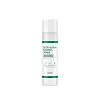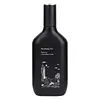What's inside
What's inside
 Key Ingredients
Key Ingredients

 Benefits
Benefits

 Concerns
Concerns

 Ingredients Side-by-side
Ingredients Side-by-side

Water
Skin ConditioningCentella Asiatica Extract
CleansingDipropylene Glycol
HumectantPanthenol
Skin ConditioningEctoin
Skin ConditioningMadecassoside
AntioxidantAsiaticoside
AntioxidantAsiatic Acid
Skin ConditioningMadecassic Acid
Skin ConditioningCeramide EOP
Skin ConditioningCeramide NP
Skin ConditioningCeramide Ns
Skin ConditioningCeramide As
Skin ConditioningCeramide AP
Skin ConditioningGlycerin
HumectantAmmonium Acryloyldimethyltaurate/Vp Copolymer
Betaine
HumectantSodium Hyaluronate
HumectantAllantoin
Skin ConditioningLimnanthes Alba Seed Oil
Skin ConditioningCanola Oil
EmollientHelianthus Annuus Seed Oil
EmollientArgania Spinosa Kernel Oil
EmollientDipotassium Glycyrrhizate
HumectantXanthan Gum
EmulsifyingPantolactone
HumectantPolyglyceryl-10 Stearate
Skin ConditioningWater, Centella Asiatica Extract, Dipropylene Glycol, Panthenol, Ectoin, Madecassoside, Asiaticoside, Asiatic Acid, Madecassic Acid, Ceramide EOP, Ceramide NP, Ceramide Ns, Ceramide As, Ceramide AP, Glycerin, Ammonium Acryloyldimethyltaurate/Vp Copolymer, Betaine, Sodium Hyaluronate, Allantoin, Limnanthes Alba Seed Oil, Canola Oil, Helianthus Annuus Seed Oil, Argania Spinosa Kernel Oil, Dipotassium Glycyrrhizate, Xanthan Gum, Pantolactone, Polyglyceryl-10 Stearate
Water
Skin ConditioningButylene Glycol
HumectantGlycerin
HumectantGlycereth-26
HumectantNiacinamide
SmoothingDiethoxyethyl Succinate
SolventTrehalose
HumectantPentylene Glycol
Skin ConditioningCamellia Sinensis Leaf Extract
AntimicrobialSodium Polyacryloyldimethyl Taurate
Emulsion StabilisingPanthenol
Skin ConditioningDipropylene Glycol
HumectantHydrogenated Polydecene
Emollient1,2-Hexanediol
Skin ConditioningAmmonium Acryloyldimethyltaurate/Vp Copolymer
Xanthan Gum
EmulsifyingAdenosine
Skin ConditioningDisodium EDTA
Methylpropanediol
SolventSodium Hyaluronate
HumectantHippophae Rhamnoides Fruit Extract
Skin ConditioningButyrospermum Parkii Butter Extract
Skin ConditioningBiosaccharide Gum-4
Skin ConditioningPolyglyceryl-10 Myristate
Skin ConditioningCnidium Officinale Rhizome Extract
Skin ConditioningEclipta Prostrata Extract
Skin ConditioningBiota Orientalis Leaf Extract
HumectantPaeonia Lactiflora Root Extract
Skin ConditioningPoria Cocos Extract
Skin ConditioningPanax Ginseng Root Extract
EmollientHydrolyzed Hyaluronic Acid
HumectantHydroxypropyltrimonium Hyaluronate
Polygonum Multiflorum Root Extract
Skin ConditioningCaprylic/Capric Triglyceride
MaskingCetyl Ethylhexanoate
EmollientBeta-Glucan
Skin ConditioningEthylhexyl Palmitate
EmollientCoptis Japonica Extract
AntimicrobialScrophularia Buergeriana Extract
Skin ConditioningScutellaria Baicalensis Root Extract
AstringentGardenia Florida Fruit Extract
Skin ConditioningPhellodendron Amurense Bark Extract
Skin ConditioningPiper Methysticum Root Extract
Skin ConditioningMacadamia Ternifolia Seed Oil
EmollientSodium Hyaluronate Crosspolymer
HumectantAcetyl Hexapeptide-8
HumectantGlucose
HumectantCentella Asiatica Extract
CleansingSaccharomyces Ferment Filtrate
HumectantSodium Acetylated Hyaluronate
HumectantPhytosteryl/Behenyl/Octyldodecyl Lauroyl Glutamate
Skin ConditioningCholesterol
EmollientBrassica Campestris Sterols
EmollientHydrogenated Lecithin
EmulsifyingArtemisia Capillaris Extract
Polyglyceryl-10 Oleate
Skin ConditioningPotassium Cetyl Phosphate
EmulsifyingCeramide NP
Skin ConditioningAsiaticoside
AntioxidantAsiatic Acid
Skin ConditioningMadecassoside
AntioxidantMadecassic Acid
Skin ConditioningCeramide Ns
Skin ConditioningCeramide EOP
Skin ConditioningCarbomer
Emulsion StabilisingCaprylyl Glycol
EmollientTrideceth-10
CleansingCaramel
Cosmetic ColorantFructose
HumectantMaltodextrin
AbsorbentPolysilicone-15
UV FilterHydroxyacetophenone
AntioxidantTromethamine
BufferingEthylhexylglycerin
Skin ConditioningWater, Butylene Glycol, Glycerin, Glycereth-26, Niacinamide, Diethoxyethyl Succinate, Trehalose, Pentylene Glycol, Camellia Sinensis Leaf Extract, Sodium Polyacryloyldimethyl Taurate, Panthenol, Dipropylene Glycol, Hydrogenated Polydecene, 1,2-Hexanediol, Ammonium Acryloyldimethyltaurate/Vp Copolymer, Xanthan Gum, Adenosine, Disodium EDTA, Methylpropanediol, Sodium Hyaluronate, Hippophae Rhamnoides Fruit Extract, Butyrospermum Parkii Butter Extract, Biosaccharide Gum-4, Polyglyceryl-10 Myristate, Cnidium Officinale Rhizome Extract, Eclipta Prostrata Extract, Biota Orientalis Leaf Extract, Paeonia Lactiflora Root Extract, Poria Cocos Extract, Panax Ginseng Root Extract, Hydrolyzed Hyaluronic Acid, Hydroxypropyltrimonium Hyaluronate, Polygonum Multiflorum Root Extract, Caprylic/Capric Triglyceride, Cetyl Ethylhexanoate, Beta-Glucan, Ethylhexyl Palmitate, Coptis Japonica Extract, Scrophularia Buergeriana Extract, Scutellaria Baicalensis Root Extract, Gardenia Florida Fruit Extract, Phellodendron Amurense Bark Extract, Piper Methysticum Root Extract, Macadamia Ternifolia Seed Oil, Sodium Hyaluronate Crosspolymer, Acetyl Hexapeptide-8, Glucose, Centella Asiatica Extract, Saccharomyces Ferment Filtrate, Sodium Acetylated Hyaluronate, Phytosteryl/Behenyl/Octyldodecyl Lauroyl Glutamate, Cholesterol, Brassica Campestris Sterols, Hydrogenated Lecithin, Artemisia Capillaris Extract, Polyglyceryl-10 Oleate, Potassium Cetyl Phosphate, Ceramide NP, Asiaticoside, Asiatic Acid, Madecassoside, Madecassic Acid, Ceramide Ns, Ceramide EOP, Carbomer, Caprylyl Glycol, Trideceth-10, Caramel, Fructose, Maltodextrin, Polysilicone-15, Hydroxyacetophenone, Tromethamine, Ethylhexylglycerin
 Reviews
Reviews

Ingredients Explained
These ingredients are found in both products.
Ingredients higher up in an ingredient list are typically present in a larger amount.
Ammonium Acryloyldimethyltaurate/Vp Copolymer (let's call it AAVC for short) is a synthetically created polymer. It's used as a film-forming agent and used to thicken the consistency of products.
AAVC is able to increase the consistency and viscosity of products due to its large molecule size. It also prevents ingredients from separating.
Asiatic Acid is a major component of Centella Asiatica Extract. It has wound-healing, anti-inflammatory, and antioxidant properties.
Studies show Asiatic Acid is able to block the pathway for skin inflammation receptors, helping to soothe skin.
As an antioxidant, asiatic acid helps protect our skin against damaging environmental factors.
Learn more about Asiatic AcidAsiaticoside comes from the super popular skin-soothing ingredient, Centella asiatica. It is one of four active compounds found in the extract of Centella Asiatica.
Asiaticoside is an antioxidant and helps with wound healing. It has been shown to increase antioxidant activity during the wound healing process.
Centella Asiatica Extract (Centella) is derived from an herb native to Southeast Asia. It is famous for its anti-inflammatory and soothing properties.
Centella is rich in antioxidants and amino acids, such as Madecassic Acid and Asiaticoside.
Studies show the compounds in centella help with:
The combination of all these properties makes centella effective at soothing, hydrating, and protecting the skin.
Other great components of centella include Vitamin A, vitamin C, several B vitamins, and Asiatic Acid.
Fun fact: Centella has been used as a medicine and in food for many centuries. As a medicine, it is used to treat burns, scratches, and wounds.
Learn more about Centella Asiatica ExtractCeramide EOP is formally known as Ceramide 1 and Ceramide 1 A.
EOP stands for a linked Ester fatty acid, a linked Omega hydroxy fatty acid, and the Phytosphingosine base.
Ceramides are intercellular lipids naturally found in our skin. They bind dead skin cells together to create a barrier. The ceramides in our skin have the ability to hold water to keep our skin hydrated.
Ceramides are an important building block for our skin barrier. A strong skin barrier helps with:
If you would like to eat ceramides, sweet potatoes contain a small amount.
Read more about other common types of ceramides here:
Learn more about Ceramide EOPCeramide NP is a type of ceramide and formally known as ceramide 3.
Ceramides are intercellular lipids naturally found in our skin that bonds dead skin cells together to create a barrier. They are known for their ability to hold water and thus are a great ingredient for dry skin.
Ceramides are an important building block for our skin barrier. A stronger barrier helps the skin look more firm and hydrated. By bolstering the skin ceramides act as a barrier against irritating ingredients. This can help with inflammation as well.
If you would like to eat ceramides, sweet potatoes contain a small amount.
Read more about other common types of ceramides here:
Ceramide AP
Ceramide EOP
Ceramide NS is formally known as Ceramide 2. It is one of the major ceramides in the stratum corneum (outermost layer of skin) plays a role in forming a protective barrier.
Due to its structure, skin lipids can be packed tightly and in turn, this strengthens the barrier and reduces water loss.
Studies show conditions like atopic dermatitis can worsen when ceramide NS levels are low.
Learn more about Ceramide NsDipropylene Glycol is a synthetically created humectant, stabilizer, and solvent.
This ingredient helps:
Dipropylene glycol is technically an alcohol, but it belongs to the glycol family (often considered part of the ‘good’ alcohols). This means it is hydrating and gentle on skin unlike drying solvent alcohols like denatured alcohol.
As a masking agent, Dipropylene Glycol can be used to cover the smell of other ingredients. However, it does not have a scent.
Studies show Dipropylene Glycol is considered safe to use in skincare.
Learn more about Dipropylene GlycolGlycerin is already naturally found in your skin. It helps moisturize and protect your skin.
A study from 2016 found glycerin to be more effective as a humectant than AHAs and hyaluronic acid.
As a humectant, it helps the skin stay hydrated by pulling moisture to your skin. The low molecular weight of glycerin allows it to pull moisture into the deeper layers of your skin.
Hydrated skin improves your skin barrier; Your skin barrier helps protect against irritants and bacteria.
Glycerin has also been found to have antimicrobial and antiviral properties. Due to these properties, glycerin is often used in wound and burn treatments.
In cosmetics, glycerin is usually derived from plants such as soybean or palm. However, it can also be sourced from animals, such as tallow or animal fat.
This ingredient is organic, colorless, odorless, and non-toxic.
Glycerin is the name for this ingredient in American English. British English uses Glycerol/Glycerine.
Learn more about GlycerinMadecassic Acid is a major component of Centella Asiatica Extract. It has anti-inflammatory and antioxidant properties.
It is a triterpenoid, meaning it naturally acts as an antioxidant. Antioxidants protect your skin against damage from environmental factors such as pollution and UV.
Studies show Madecassic Acid helps soothe the skin due to its ability to block inflammation pathways.
Learn more about Madecassic AcidMadecassoside comes from the super popular skin-soothing ingredient, Centella asiatica. It is one of four active compounds found in the extract of Centella Asiatica.
Madecassoside has antioxidant, anti-inflammatory, and hydrating properties. It contains fatty acids, amino acids, beta-carotene, and phytochemicals.
One study found using Madecassoside with ascorbic acid helped reduce the signs of aging and improved skin hydration.
Learn more about MadecassosidePanthenol is a common ingredient that helps hydrate and soothe the skin. It is found naturally in our skin and hair.
There are two forms of panthenol: D and L.
D-panthenol is also known as dexpanthenol. Most cosmetics use dexpanthenol or a mixture of D and L-panthenol.
Panthenol is famous due to its ability to go deeper into the skin's layers. Using this ingredient has numerous pros (and no cons):
Like hyaluronic acid, panthenol is a humectant. Humectants are able to bind and hold large amounts of water to keep skin hydrated.
This ingredient works well for wound healing. It works by increasing tissue in the wound and helps close open wounds.
Once oxidized, panthenol converts to pantothenic acid. Panthothenic acid is found in all living cells.
This ingredient is also referred to as pro-vitamin B5.
Learn more about PanthenolSodium Hyaluronate is hyaluronic acid's salt form. It is commonly derived from the sodium salt of hyaluronic acid.
Like hyaluronic acid, it is great at holding water and acts as a humectant. This makes it a great skin hydrating ingredient.
Sodium Hyaluronate is naturally occurring in our bodies and is mostly found in eye fluid and joints.
These are some other common types of Hyaluronic Acid:
Learn more about Sodium HyaluronateWater. It's the most common cosmetic ingredient of all. You'll usually see it at the top of ingredient lists, meaning that it makes up the largest part of the product.
So why is it so popular? Water most often acts as a solvent - this means that it helps dissolve other ingredients into the formulation.
You'll also recognize water as that liquid we all need to stay alive. If you see this, drink a glass of water. Stay hydrated!
Learn more about WaterXanthan gum is used as a stabilizer and thickener within cosmetic products. It helps give products a sticky, thick feeling - preventing them from being too runny.
On the technical side of things, xanthan gum is a polysaccharide - a combination consisting of multiple sugar molecules bonded together.
Xanthan gum is a pretty common and great ingredient. It is a natural, non-toxic, non-irritating ingredient that is also commonly used in food products.
Learn more about Xanthan Gum